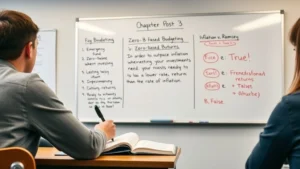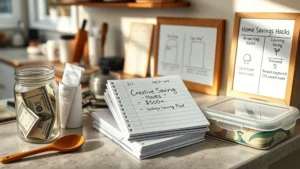Debt, Sneaky Friend or Foe?
You ever wake up and wonder, “Wait, how did I get HERE with my credit cards?” Maybe it started as just harmless coffee runs or a new gadget every other month… and then suddenly, oof, you’ve got that gut-dropping feeling checking your statement. I know, because I’ve been there—so have most people, whether they admit it or not. The thing is, most of us get budgeting wrong because we think it’s all about the math. Numbers, spreadsheets, cutbacks. But honestly? The real magic happens way before you open a calculator or print a budget sheet.
That’s what the whole idea behind The Second Foundation Get out of debt and is about. Foundations. Not house kind (unless you budget like I used to, in which case—your money house has a leaky basement). I’m talking about those first few pillars that hold up your whole life. Get this part right, and everything else just feels… lighter. Like, you can actually breathe.
Why Does Debt Just… Happen?
How the Little Stuff Becomes Big, Fast
You’re not careless. Debt sneaks up because it hides in everyday “yeah, sure” moments. That $14 streaming subscription you swore you’d cancel after the free trial? Still there. Holiday sales? Ugh, they’ll get you too. Before you know it, you’re adding up balances across three cards, maybe a car loan, and some old student debt for flavor.
The wildest thing? Most people don’t mess up because they’re bad at math. It’s more about blind spots and ignoring feelings. Remember The first foundation is save answers? It’s about paying attention to where your money flies off to—being honest, not just organized. I once realized I was spending $60 a month on “convenience” (a muffin here, an app there). When I tracked it, I was weirdly relieved (and a little mad at myself).
Case in Point: The Vacation That Sparked Change
Let’s get real for a sec. There was a couple, John and David Auten-Schneider, who shared their story on a finance podcast—a “drive-home-from-vacation” forced confession. They had $51,000 in credit card debt, despite working in finance! (Yep, even the pros mess up.) It wasn’t until they faced that big, hairy number together that things started changing. No more denying, no more hiding from the numbers. Sometimes, a truth bomb is the first act of love you give your future self.
Missing Deadlines…More Than Just Annoying
Ever skip a credit card payment, even just by a few days? Feels small. But if you make a late credit payment, you might see the lender add extra fees, maybe even a terrifying interest hike. I’ve gotten those surprise $39 penalties—makes you want to crawl under the covers.
| What Happens? | The Cost | How to Dodge It |
|---|---|---|
| Missed Credit Payment | $30–$40 fee, higher interest | Automate bills, set calendar alerts |
| Consistent On-Time Payments | Savings, better credit score | Peace of mind (and bragging rights) |
| Start the Debt Snowball | Boosts motivation, small wins | Track progress, celebrate the tiny stuff |
I totally get that pit-in-your-stomach feeling from a silly mistake. Now, I have all my payments scheduled two days before the real due date (just to give myself wiggle room for, you know, being human).
Break Free: Real Ways Out
Which Payoff Plan Fits? Let’s Get Personal
So, you’ve admitted the debt is there (high five, seriously). Now what? Everyone yells about “methods,” but here’s the tea: You gotta pick something that excites you, or it won’t stick. Debt payoff’s a journey, not a single big movement.
There are two biggies: the snowball and the avalanche. What’s the difference?
| Method | How It Works | Why People Like It |
|---|---|---|
| Snowball | Pay off smallest debt first, then roll that payment to the next one | Quick wins, boosts motivation, feels doable research on different payoff approaches |
| Avalanche | Target highest interest first, saves most money long term | Mathematically best, but sometimes feels slow or frustrating comparison of snowball and avalanche |
Honestly? I did the snowball. I needed to see those little victories, or I’d get discouraged. Knocking out a $400 old store card in two months? That felt good. My friend preferred the “avalanche” though—she’s all about maximizing every dollar.
Try This: Debt Lasso (!?)
John and David (remember those $51k guys?) got creative. They used what they called the “Debt Lasso” by hopping balances to 0% interest cards. No, it wasn’t magic, and yes—it required discipline. But by lowering interest, every payment went farther. Maybe you try that. Maybe you just need a buddy to coach you through listing out your balances (text a friend, really).
Do Budgeting Without Hating Life
I’ll be real—budgeting used to sound like diet talk (“No, you can’t have that. Or that. Or that!”). That never lasted for me. What works? A simple, messy list. Know what your “wants,” “needs,” and “oops, definitely forgot about that one” are.
This is where the The first foundation is save answer key comes in. Think flashcards. What bills are non-negotiable? Which ones could you cut (like, that random streaming service)? Every time you shave off a useless expense, aim it straight at your tiniest balance. Suddenly, the math works in your favor.
Everyday Examples That Make a Difference
Small changes, big relief. My buddy started cooking “wannabe chef” meals at home (his early attempts were…interesting) and swapped out brand names for store brands. Boom. $200 saved in a month. He aimed half of that at his debt. It’s not about living like a monk. It’s about making your progress visible, any way you can.
- Try a 0% balance transfer card (read the fine print, but it works if you set an end-date alarm!)
- Sell something you never use—old gadgets, clothes. Stack those bucks right on your next payment.
- Spend an extra half-hour a week on a side hustle. Don’t overdo it—just enough to speed things up, not burn you out.
All these everyday hacks sound like little pebbles… but over time, you get a landslide. (Or a snowball, I guess?) Tie this mindset to the fifth foundation: build wealth and be outrageously—it’s not just about surviving. Debt freedom unlocks your next big level, truly.
Staying Out: The Secret Sauce
The Danger Zone After Zero
You paid it off. You danced in the kitchen. Next month? New shoes, a taco splurge, backslide. Ugh, right?! Those same pros (John and David) slid right back into $6,000 of debt after their first victory lap. Painful. But—hear me out—that’s normal. Honestly, it happens because habits didn’t change, just the numbers.
Here’s the trick: Make debt freedom not just a finish line but the start of something new. Track your wins, however tiny. Set up super-low “walls” (like a small savings buffer). Journal out why you felt like spending in the first place. (I realized boredom cost me more than any emergency ever did…so now I keep a list of “fun, free” activities for those days.)
Tie your new habits to a better goal—one that makes you excited. Dreaming about a vacation, a hobby, or helping family? Write it out and stick it to your fridge. Seriously, your future self will thank you. For even more motivation, peek at the fifth foundation: build wealth and be outrageously—saving is one thing, but you want to thrive, right?
Debate Time: Crush Debt or Start Investing?
Here’s a hot topic. Some people say, “Should I dump every spare dollar on my debt…or start investing, too?” Let’s be honest—if your cards are charging you 19% interest, that’s a “guaranteed” loss unless you tackle it. Paying debt is like an investment that always pays off (“Congrats, you saved $200 in interest this year!”). But if your rates are low, maybe blend: pay a solid chunk to debt, then stash a bit in a high-yield savings account or beginner investment (think: boring, never risky!).
| Plan | Why It’s Good | Why Be Careful |
|---|---|---|
| All-In on Debt | No more interest bleeding you dry. “Peace of mind” goes a long way. | Slower wealth-building, can feel restrictive in the short-term. |
| Split with Investing | Early exposure to growth. Great if rates are truly low. | If you make a late credit payment, you might see the lender add fees—so be sure to stay on top of it! |
The point: don’t overcomplicate. Pick the plan that you’ll stick to—messy, human, real.
Conclusion: You’ve Got This (Promise)
Okay, friend, you made it to the end—and maybe you even cracked a smile. The Second Foundation Get out of debt and is all about laying down the real, lasting groundwork so you can break free from that anxious, stuck feeling. We looked at why debt creeps up (and how to spot it sooner), simple ways to slay your balances (hello, snowball or avalanche!), and building the habits you need to stay free. Remember, slip-ups happen, but every small win is a step toward a life you actually want, not just one you “manage.”
Starting is the hardest bit—so just take one, weirdly specific action today. List your debts, automate a payment, or text a friend for moral support. Get loud about your financial wins (even if it’s “didn’t order takeout!”). Trust me, the wins will add up. And when you’re ready for what’s next? You’ll find even more friendly, slightly messy tips at the fifth foundation: build wealth and be outrageously.
So—what’s your first step? I’m rooting for you. You deserve a money life that feels yours, not controlled by debt. Let’s start, together.












